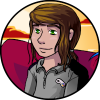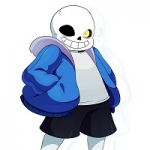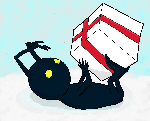The Wind Waker
The history of this one was colorful. We all should know the story by now: In the year 2000, when the Gamecube was being showcased for the first time, a tech demo was released of a one-on-one sword duel between Link and Ganondorf, in a style similar to Ocarina of Time. Zelda fans were quite pleased, believing this to be a preview of the next Zelda game. However, fast forward to a year later, when The Wind Waker was first revealed, and the graphical style was instead a cuter, cartoonish, cel-shaded look. The reaction was mixed at best, fans being disappointed that the graphical style of the 2000 demo was being scrapped, and others feeling the look was too "kiddie," and that the Zelda franchise was in danger.
Oh, how wrong they all were.
What we got was one of the most unique entries in the series to date. It still followed the Zelda formula, but in a new way. Gone were the open fields and terrain, replaced instead by islands and ocean. Story was also a main focus, for the first time since A Link to the Past, we actually get to see the lore of the Zelda universe treated as, well, a legend. The game opens up recounting the story of Ocarina of Time, but in a painting, like a scroll, complete with a somber melody and a remix of the classic Zelda tune. However, it also reveals to us that Ganon returned, but the Hero did not, and Hyrule's fate was left mysterious. It concludes telling us of a tradition on an island where boys of age are garbed in green.
Then the game opens on Outset Island, and here's where the first shaking up of the Zelda formula happens: We get to see Link's family, and friends, and get to take control of Link and experience a small taste of his home life instead of directly being thrust into an adventure. Sure, one could argue we could do the same in Ocarina of Time, but the game still pretty much nudges you to adventure from the start. Wind Waker does not, as instead Link explores his town, learning little tips, collecting rupees, bringing little pigs to your neighbor to keep as pets, learning sword techniques from Orca... and getting embarrassed by your grandma. It's all a very tight-knit community, or so it seems, and everyone seems to have their own little quirks and habits. Then there's Link's sister, Aryll, the one that spurs him on this quest, when she's soon kidnapped by a giant bird mistaking her for a pirate girl it dropped on the summit's forest. These pirates, the girl being their leader, Tetra, are the ones who take Link, after he acquires his sword and shield, to the first leg of his quest, to where Link's sister was taken.
You're launched into the Forsaken Fortress, but you lose your sword. This is another shake-up: A stealth section. If you get caught by searchlights, tossed into prison. Moblins? Tossed into prison. You can escape, but you now know you have to be careful, sneaking around using barrels as cover. You have to disable the searchlights by taking out the Bokoblins, introducing another new feature: Disarming. Of course, this is as simple as blocking their strikes with your shield until they drop their weapon, but it's still neat. Then you defeat them with their own weapon and you can move on. However, upon reaching your sword and where Aryll is held along with two other girls, you're grabbed by the giant bird and tossed away again, by the command of a dark being within the Fortress.
I'm starting to recount the entire thing again, so let me try to be brief. You learn your new system of navigation quickly: Sailing. In a talking boat. The ocean is vast, the islands are many, and there's secrets aplenty. The graphical style is quite charming and beautiful. The characters are quirky, and the world feels very lively whenever there's people around. There's a lot of depth to this game, and it shows. Maybe too much, because sailing can be quite tedious on occasion, but I do feel they captured the feeling of sailing quite well despite this. The engine itself is quite the vast improvement upon the N64 engine, including a free camera mode which is quite handy. Everything feels smoother, apart from jumping mechanics, which is the only issue I take with post-N64 3D Zelda titles: The N64 games let you control your jump in midair, whereas in Wind Waker and onward, once you jump, you're stuck on that trajectory. However, this does not hurt the game, though some sections would be far less tedious if jumping were the same as in Ocarina of Time or Majora's Mask.
Musical instruments return as well. Sort of. The titular Wind Waker is a conductor's baton, allowing you to "conduct" songs that have various effects, such as controlling the wind's direction, changing night to day and vice-versa, warping to another part of the ocean, or simply plot devices. These are actually somewhat tedious, but mostly just the Wind's Requiem; you'll often need to change the wind's direction, and for a three-note song, it seems to take forever to complete. This could maybe have been handled a little better, but similarly doesn't really affect the rest of the game.
Now, dungeons. Yeah, Wind Waker doesn't have a ton of them, seven at most depending on how you count them, and two of those are smaller "dungeons" anyway. But what dungeons it does have are pretty strong, clever dungeons. Dragon Roost Cavern, for example, is a spectacular dungeon, and it's only the first one in the game! In fact, all of the dungeons are quite strong, especially the final two temples, which boast collaborative play between Link and one of two helpers: Medli the Rito, Sage of Earth; and Makar the Korok, Sage of Wind. Okay, so the tediousness of the Wind Waker songs, this time the Command Melody, come back into play here, and did for a bit in Tower of the Gods, the third dungeon, but otherwise, the puzzles and collaboration were strong, and were yet another addition to the list of things Wind Waker did to shake things up a bit. Forsaken Fortress was more of a stealth segment the first time and a fortress-storming the second, but it was fun for both of those things. Ganon's Tower was more of your typical final area-type thing like in Ocarina of Time, complete with boss rematches, which are fun. So yeah, the dungeons, though few, were still pretty strong.
I really can't speak enough of how much I enjoy this game. There was just so much substance to it, be it secrets to find dotted on each island, trading sequences, fun minigames featuring Salvatore, neat sidequests, and even an auction minigame, that it's practically packed full-to-bursting even with the low dungeon count. The sailing could go from calm and peaceful to hazardous in the blink of an eye; Seahats are truly terrifying things if you're not prepared for them. Oh, and sharks known as Gyorgs appear, and just like their namesake, they're quite annoying. And then there are the Big Octos that appear. The sea is also rife with life, just as the islands are. I could go on and on about the music, but I'll sum it up by saying it's among the best in the series and lends very well to the atmosphere.
And the story. My God, the story. Oh, sure, eventually we find out Tetra was Zelda, and she gets kidnapped, but that's only part of it. See, Link was never out to save Zelda until near the end. No, he was in it to save his little sister. He just got roped into something more: The return of Ganondorf and the need to put him down once again. Then we learn of Hyrule's true fate: It was flooded by the goddesses in an attempt to subdue Ganondorf, and their chosen few were sent to the mountaintops to live out a new existence as islanders. Pretty depressing, especially for this game's bright visual style and often comical moments. Heck, the story only continues to be depressing. Turns out, Ganondorf's more of a tragic character than we realized, as he reveals just how harsh it was living in the Gerudo climate, and how he coveted the "life-bringing winds" of Hyrule. His mind was warped, no doubt boosted by his being an incarnation of a demon, which led him to attempt to conquer Hyrule repeatedly. And then there's the King, the strong and caring guardian who guides Link on his journey as the boat known as the King of Red Lions. Turns out he was always full of regrets, and when Ganondorf assembled the Triforce, the King intercepted it and wished for "hope" for Link and Zelda's future. And requesting Hyrule be washed away forever. Yes, the game went there. The game wiped out the very land of the Legend of Zelda. It was bold. It was daring. And it couldn't have ended any other way. And even more, after Ganondorf is turned to stone and the waters finally engulf Hyrule, the King remains submerged. Link, being pulled to the surface along with Zelda, attempts to reach out to him. The King extends a hand, then withdraws it, choosing to drown with Hyrule.
What a depressing ending. And yet, beautiful. Poetic. Sad. The game first surprised us with its cartoony style, then surprised us again with its deep, rich, sad story. How anyone can say Nintendo didn't strike gold with this formula is beyond me.
The game does have its annoyances, mostly little things, but otherwise some tedious moments, such as Triforce Charts and collecting the shards of the Triforce of Courage. Maybe it would have been better if these shards were hidden where the charts were instead, but it still feels like a small complaint next to the sheer scope of this game. There's really not a whole lot to criticize compared to how many things this game did right. Maybe it could have used a couple more dungeons, and a bit less tedium in places. The Wind Waker not quite perfect, but it still, in my eyes, remains a masterpiece.
But Floormasters will always be one of my most-hated foes.
![]()








